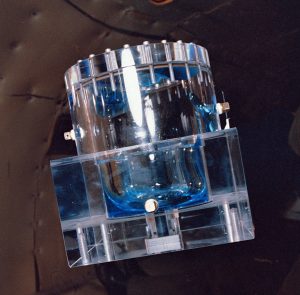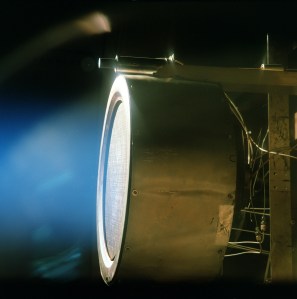Mars Pathfinder was launched on December 4, 1996 at 1:58:07 am EST on a Delta II rocket. After an uneventful journey, the spacecraft safely landed on the surface of Mars on July 4, 1997. Its landing on the Ares Vallis plain was confirmed at 1:07 p.m. EDT. The air bag landing system, tested at Glenn’s Plum Brook Station in Sandusky, Ohio, performed well. The first set of data was received shortly after 5:00 p.m. followed by the release of images at 9:30 p.m. The Sojourner rover, with three Lewis components, then began its Martian trek and returned images and other data over the course of three months. After operating on the surface of Mars three times longer than expected and returning a tremendous amount of new information about the red planet, NASA’s Mars Pathfinder mission completed the last successful data transmission cycle from Pathfinder at 6:23 a.m. EDT on Sept. 27, 1997.
NASA’s Glenn Research Center has a long history of involvement with missions to Mars. Glenn managed the launch of the Mariner, Viking and Mars Observer missions. NASA Glenn was a key participant in the Mars Pathfinder mission, an engineering proof-of-concept mission. The intent was to demonstrate the successful deployment of scientific instruments, including a small rover, on a planetary body and to gain engineering design information.
NASA Glenn has been involved in the Mars Pathfinder Mission nearly from the beginning. The Mars Solar Energy Model provided an early demonstration that sufficient solar energy is available at Mars to provide operating power for a spacecraft and lander. This solar energy model was incorporated into the computer model used by JPL to design solar arrays for the Pathfinder lander, and the Sojourner Rover.
The Jet Propulsion Laboratory, which is heading the Pathfinder mission, requested Glenns’ aid in several areas. To help meet mission objectives, Glenns’ Plum Brook Station was used to test the Pathfinder airbag landing system for JPL. To help meet science objectives, JPL requested that Glenn develop a means to obtain information on the abrasiveness and adherence properties of Mars soil and dust. Consequently, Glenn developed three flight sensors for experiments on the Pathfinder Microrover, named “Sojourner.” Also delivered were several small tungsten points for removing electrostatic charge accumulated during rover surface operations.
The Wheel Abrasion Experiment (WAE) gathered soil abrasion information by observing a special rover wheel wear. The center section on one of the rover’s six wheels was coated with thin layers of nickel, aluminum, and platinum. Changes in the metal layers’ reflectance due to wear were detected by a photocell.
The Materials Adherence Experiment (MAE) was designed to determine how much dust lands on the solar array of the Sojourner Rover. It did this by using two sensors: a solar cell sensor, which measured how much light was obstructed by dust landing on a transparent cover, and a quartz crystal monitor, which measured the mass of dust deposited on the array. Some initial measurement of dust settling data has been made available.
Tests and calculations confirmed the possiblity that the rover would accumulate a large static charge during its surface operations. Since actual martian conditions are unknown, JPL followed Lewis’ recommendations and added discharge points to the rover’s antenna as a precaution. If the rover accumulated electric charge, some, or all of it should have been removed to the atmosphere through the discharge points.
More Information:
1996 NASA Lewis Press Release
1995 NASA Lewis Press Release
Landing System Tests at Plum Brook Station
Published Papers:
Landis, G.A., et al.: Development of a Mars Dust Characterization Instrument. IAF Paper 95-U.4.09, AIAA, 1995.
Jenkins, P.P.; and Landis, G.A.: A Rotating Arm Using Shape-Memory Alloy. 29th Aerospace Mechanisms Symposium. NASA CP-3293, 1995, pp. 167-171.
Siebert, M.W.; and Kolecki, J.C.: Electrostatic Charging of the Pathfinder Rover. AIAA Paper 96-0486, 1996.
Hepp, A.F., et al.: Wheel Abrasion Experiment Metals Selection for Mars Pathfinder Mission. NASA Technical Memorandum 107378, November 1996.
Mars Pathfinder was the first in the series of Discovery-class missions, a NASA initiative for small planetary missions, sponsored by NASA Headquarter’s Office of Space Science. Discovery-class missions have a maximum three-year development cycle and development cost cap of $150 million (FY 1992). The project was managed by NASA’s Jet Propulsion Lab (JPL), California Institute of Technology, Pasadena,Calif.





























